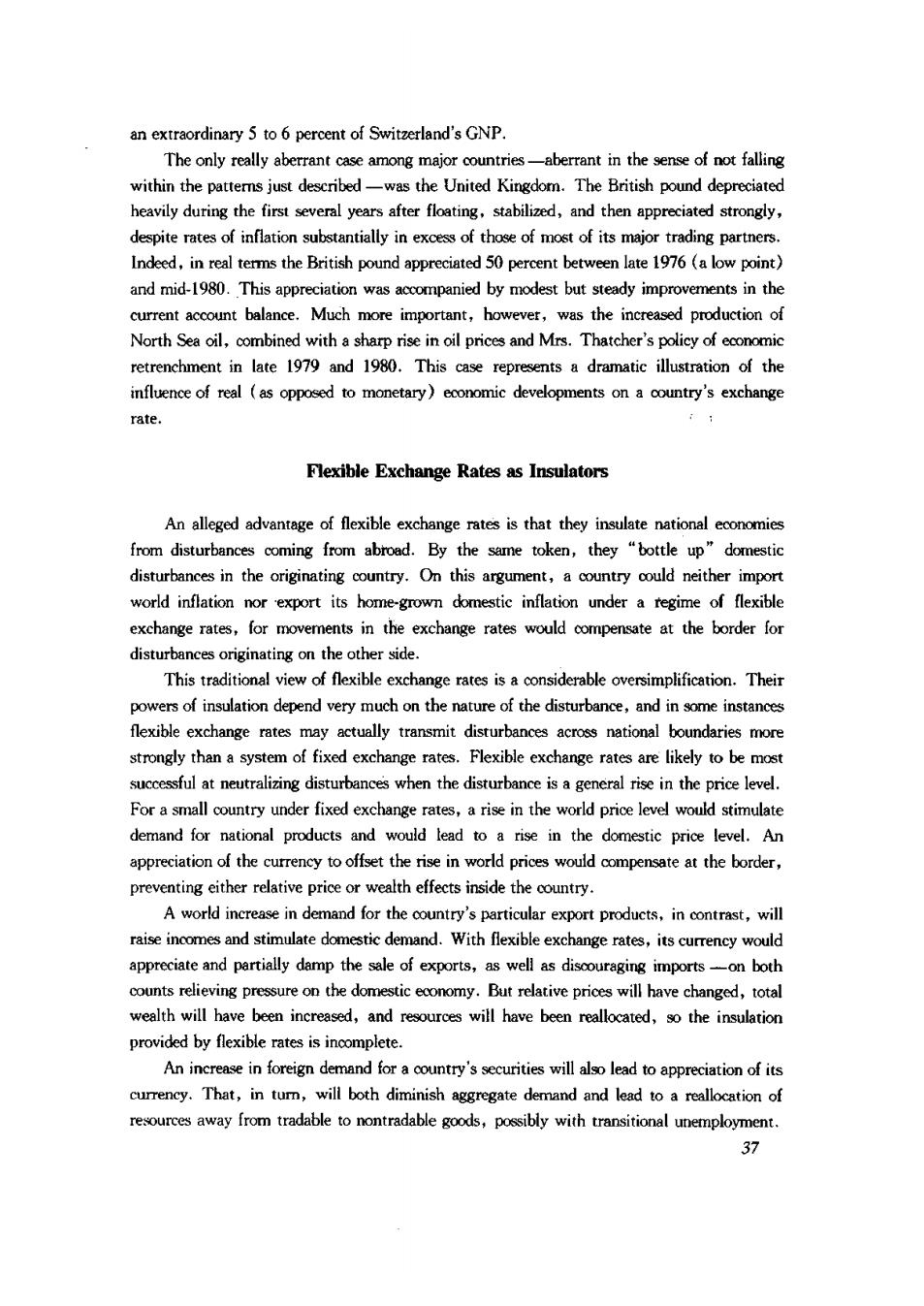
an extraordinary 5 to 6 percent of Switzerland's GNP. The only really aberrant case among major countries-aberrant in the sense ofot falling within the patters just described-was the United Kingdom.The British pound depreciated heavily during the first several years after floating.stabilized,and then appreciated strongly, despite rates of infation substantially in exc of thseof mot of its major trading partner Indeed.in real terms the British pound appreciated 50 percent between late 1976(alow point) and mid-1980.This appreciation was accompanied by modest but steady improvements in the current account balance.Much more important,however,was the increased production of North Sea oil.combined with a sharp rise in oil prices and Mrs.Thatcher's policy ofo retrenchment in late 1979 and 1980.This case represents a dramatic illustration of the influence of real (as opposed to monetary)economic developments on a country's exchange rate. Flexible Exchange Rates as Insulators An alleged advantage of flexible exchange rates is that they insulate nationalom from disturbance coming from abroad.By the same token,they"bottle up" domesti disturbances in the originating country.On this argument,a country could neither import world inflation or expor its home-grown dmestic inflation undera regime of flexible exchange rates,for movements in the exchange rates would compensate at the border for disturbances originating on the other side. This traditiona view of flexible exchange rates.Their rsof depend very muchonthe nature of the disturbance,and flexible exchange rates may actually transmit disturbances across national boundaries more strongly than a system of fixed exchange rates.Flexible exchange rates are likely to be mo successful at neutralizing disturbances when the disturbance isa general rise in the price level For a small country under fixed exchange rates,a rise in the world price level would stimulate demand for national products and would lead toa rise in the domestic price level.An appreciation of the currency to offset the rise in world prices would compensate at the border, preventing either relative price or wealth effects inside the country. Aorld increase in demand for theor's particular export products. raise incomes and stimulate domestic demand.With flexible exchange rates,its currency would appreciate and partially damp the sale of exports,as well as disoouraging imports-on both uts relieving pre nthe.prices will have changed,total wealth will have been increased,and resources will have been reallocated,so the insulation provided by flexible rates is incomplete. currency.That,in tum,will both diminish aggregate demand and lead to a reallocation of reources away from tradable to nontradable goods,possibly with transitional unemployment 37
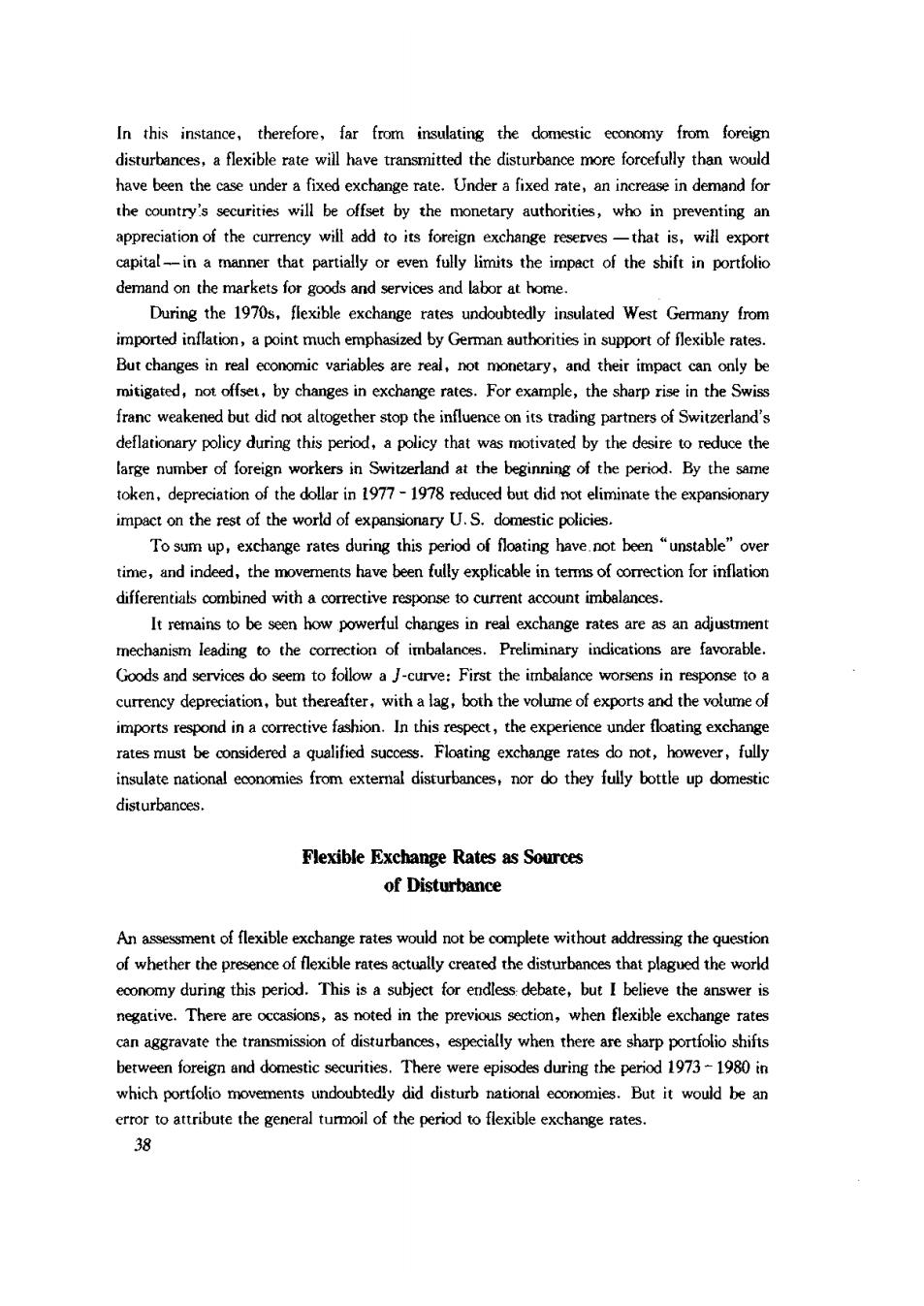
In this instance,therefore,far from insulating the domestic economy from foreign disturbances,a flexible rate will have transmitted the disturbance more forcefully than would have been the case udera fixed exchange rate.Undera fixed rate,increase in demand for the country's securities will be offset by the monetary authorities,who in preventing an appreciation of the currency will add to its foreign exchange reserves-that is,will export capital inamanner that partially or even fully limits the impact of the shift in portf demand on the markets for goods and services and labor at home During the 1970s,flexible exchange rates undoubtedly insulated West Germany from ,apoint much emphasized by of But changes in real economic variables are real,not monetary,and their impact can only be mitigated,not offset,by changes in exchange rates.For example,the sharp rise in the Swiss deflationary policy during this period,a policy that was motivated by the desire to reduce the large number of foreign workers in Switzerland at the beginning of the period.By the same the in 1977-1978rduced impact on the rest of the world of expansionary U.S.domestic policies To sum up,exchange rates during this period of floating have not been "unstable"over differentials combined with a corrective response to current account imbelances. It remains to be seen bow powerful changes in real exchange rates are as an adiustment echanism leading to the imbalan Prelimin ary indications are favorable Goods and services do seem to follow a f-curve:First the imbalance worsens in response to a currency depreciation,but thereafter.with a lag,both the volume of exports and the votume of this,theexperience under rates must be considered a qualified success.Floating exchange rates do not,however,fully insulate national economies from external disturbances,nor do they fully bottle up domestic Flexible Exchange Rates as Sources of Disturbance An ase ment of flexible exchange rates would not be complete without addressing the questio of whether the presence of flexible rates actually creared the disturbances that plagued the world economy during this period.This is a subject for endless debate,but I believe the answer is negative.There are as noted in the,when flexible exchange rate can aggravate the transmission of disturbances,especially when there are sharp portfolio shifts between foreign and domestic securities.There were episodes during the period 1973-1980 in which porfolio m error to attribute the general turmoil of the period to flexible exchange rates. 38
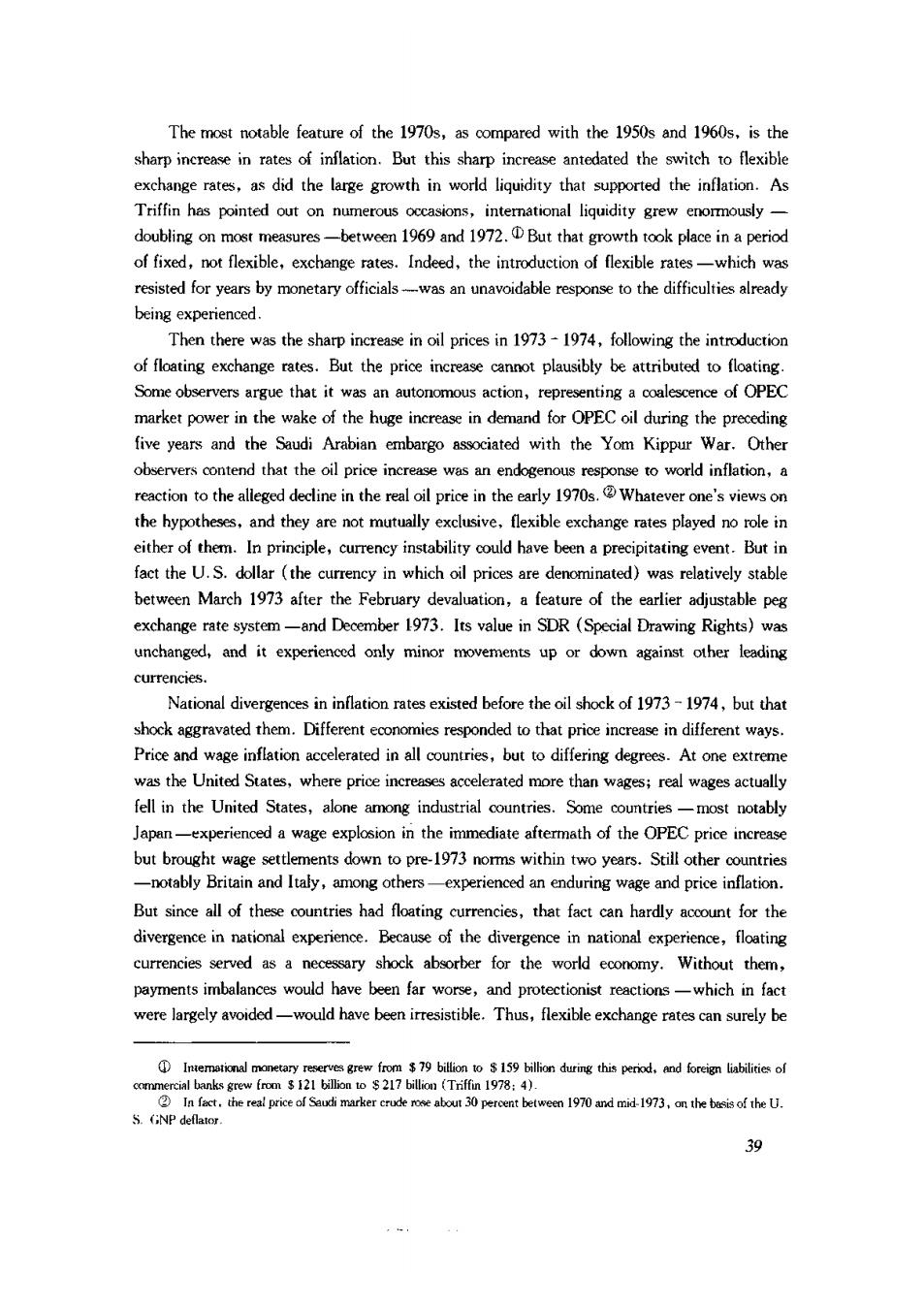
The most notable feature of the 1970s,as compared with the 1950s and 1960s,is the sharp increase in rates of inflation.But this sharp increase antedated the switch to flexible exchange rates,as did the large growth in world liquidity that supported the inflation.As Triffin has pointed out on numerous occasions,international liquidity grew enormously- doubling on most measures-between 1969 and 1972.But that growth took place in a period of fixed,not flexible,exchange rates.Indeed,the introduction of flexible rates-which was resisted for years by monetary officials-was an unavoidable response to the difficulties already being experienced. Then there was the sharp increase prices in1973-1974,following the of floating exchange rates.But the price increase cannot plausibly be attributed to floating. Some observers argue that it was an autonomous action, market power in the wake of the huge increase in demand for OPEC oil during the preceding five years and the Saudi Arabian embargo associated with the Yom Kippur War.Other observers end that the oil price incr e was an endog respon se to world inflation,a reaction to the alleged dedline in the real oil price in the early 1970s.Whatever one's views on the hypotheses,and they are not mutually exclusive.flexible exchange rates played no role in ither of them.In principle,currency instability could have bena pre cating event.But in fact the U.S.dollar (the cureny whicho pricesare denominatedwas relatively stable between March 1973 after the February devaluation,a feature of the earlier adjustable peg exchange rate system-and December 1973.Its value in SDR (Special Drawing Rights) was unchanged,and it experienced only minor movements up or down against other leading currencies. National before the oil 1973-1974,but tha shock aggravated them.Different economies responded to that price increase in different ways. Price and wage inflation accelerated in all countries,but to differing degrees.At one extreme was the United States,where price n saccelerated more than wages;real wages actully fell in the United States,alone among industrial countries.Some countries -most notably Japan-experienced a wage explosion in the immediate aftermath of the OPec price increas but brought nts down to pre-1973 nomms within two years Still other -experienced an enduring wage and price inflation. But since all of these countries had floating currencies,that fact can hardly account for the divergence in national experience.Because of the divergence in national experience,floating currencies served as a necessary shock absorber for the world economy.Without them, payments imbalances would have been far worse,and protectionist actions -which in fac were largely avoided_ ould have Thus,flexible exchange rates can surely be ① fiNP deflator. 名
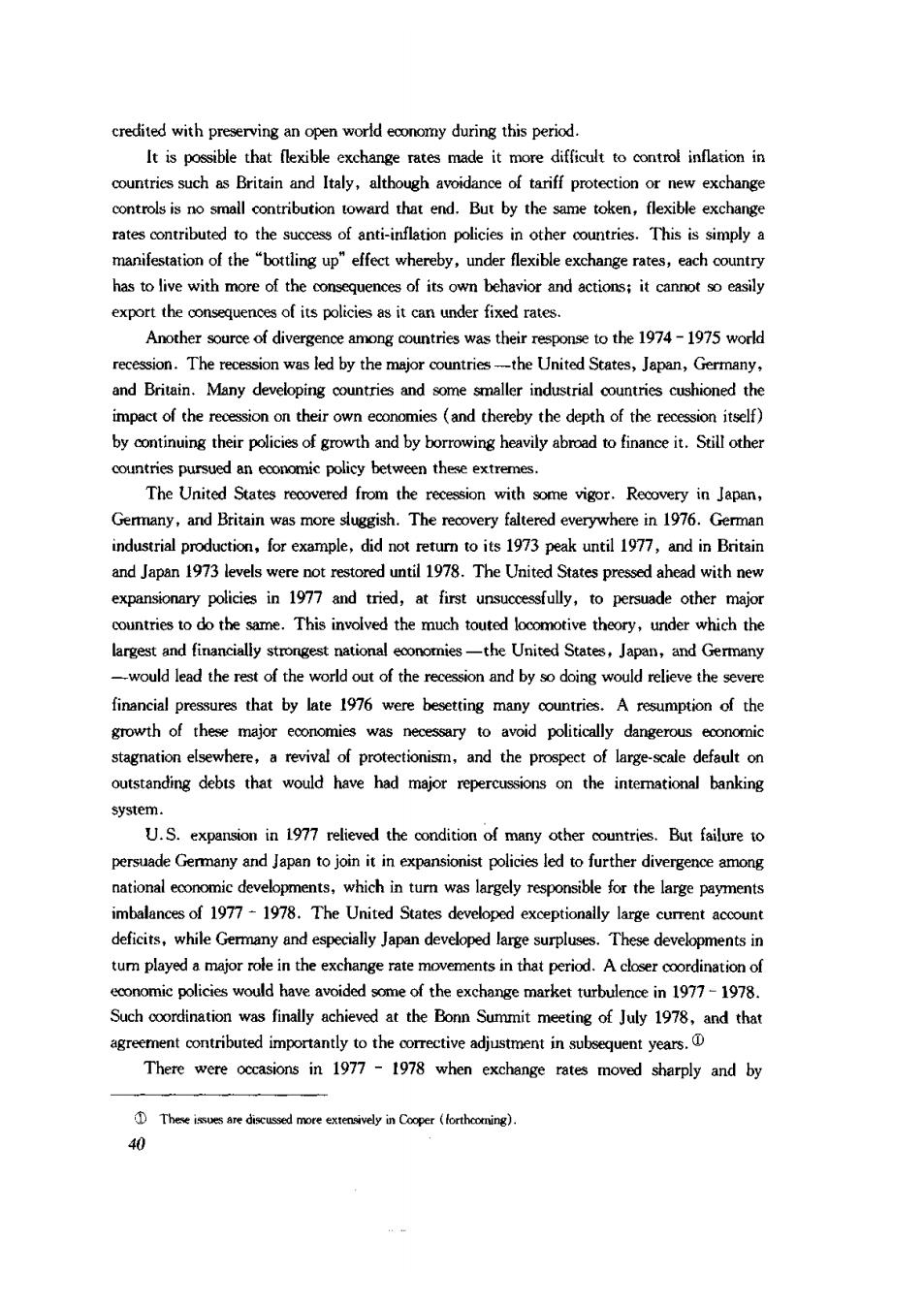
credited with preserving an open world eonomy during this period It is possible that flexible exchange rates made it more difficult to control inflation in Britain and Italy,altbough avoidance of tariff exchange toward that end.But by the same token,flexible exchange rates contributed to the success of anti-inflation policies in other oountries.This is simply a manifestation of the"botting up"effect whereby,under flexible exchange rates,each cou has to live with more of the consequencesof its own behavior and actions;it cannotsoeasily export the consequences of its policies as it can under fixed rates. among ris was to the 1974-1975word recessi.The recession was led by the mjor countries-the United Scates,Japan,Germany, and Britain.Many developing countries and some smaller industrial countries cushioned the impact of the(and thereby the depth of itsf) by continuing their policies of growth and by borrowing heavily abroad to finance it.Still other countries pursued an economic policy between these extremes The United States from the recession with some vigor.Recovery in Japan. Germany,and Britain was more sluggish.The recovery faltered everywhere in 1976.German industrial production,for example,did not retum to its 1973 peak until 1977,and in Britain and Jap1973 levels were not restored util 1978.The United States pressed ahead with new expansionary policies in 1977 and tried,at first unsuccessfully,to persuade other major countries to do the same.This involved the much touted locomotive theory,under which the the United States,Japan,and Germany would lead the rest of the world out of the recession and by so doing would relieve the severe financial pressures that by late 1976 were besetting many countries.A resumption of the growth of these major economies was necessary to avoid politically dangerous economic stagnation elsewhere,a revival of protectionism,and the prospect of large-scale defaulton outstanding debis that would have had major repercus system. U.S.expansion in 1977 relieved the condition of many other countries.But failure to national economic developments,which in turn was largely responsible for the large payments imbalancesof 1977-1978.The United States developed exceptionally large current account tum played a major role in the exchange rate movements in that period.Acloser coordination of policies would have avoided ome of the exchange market turbulence in 1977-1978. Such ordination was finally achieved at the Bonn Summit meeting of July 1978,and that agreement contributed importantly to the corrective adjustment in subsequent years. There were occasions in 1977-1978 when exchange rates moved sharply and by d These issues are discussed more extensively in Cooper fortheomning)
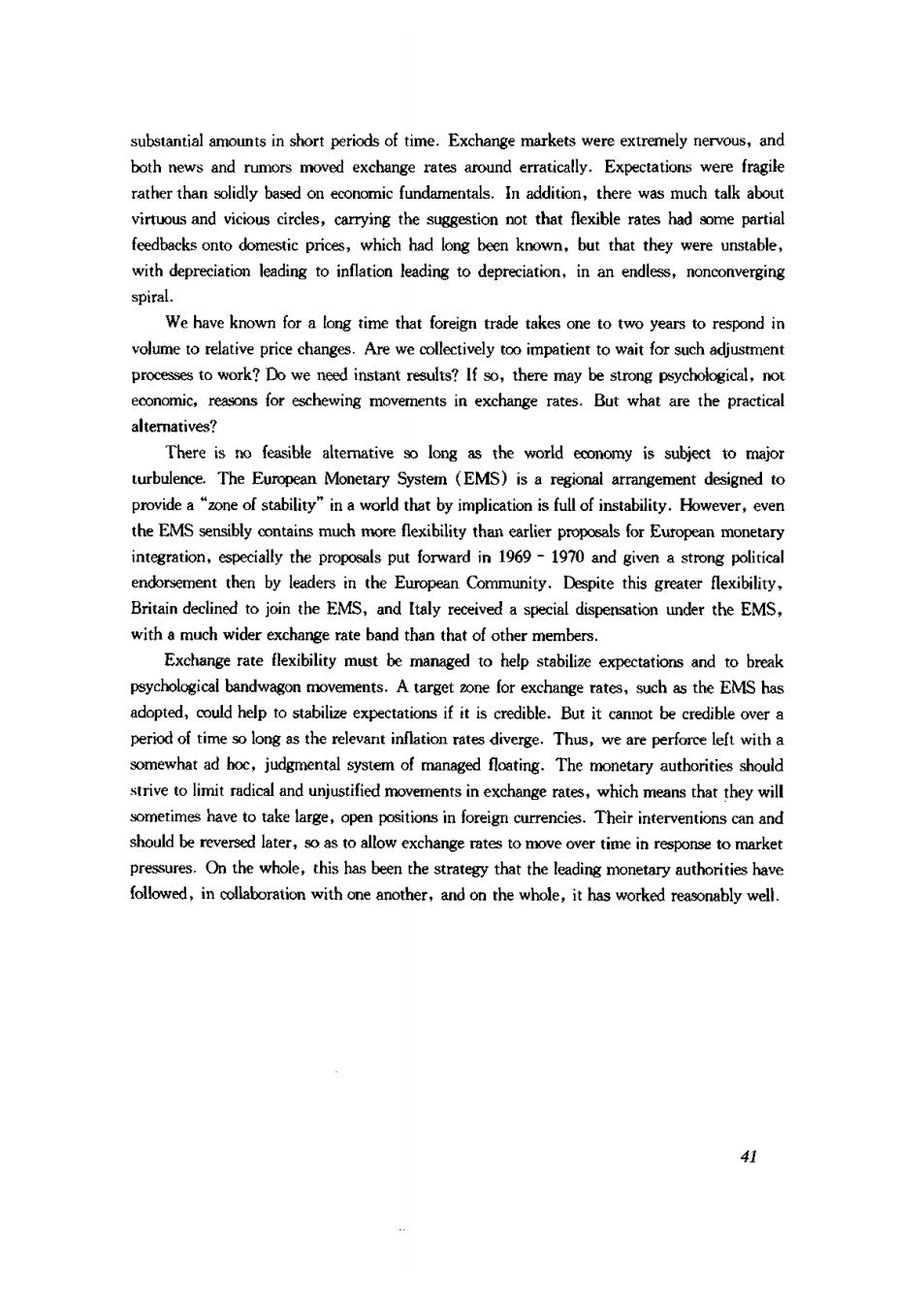
substantial amounts in short periods of time.Exchange markets were extremely nervous,and both news and rumors moved excbange rates around erratically.Expectations were fragile rather than solidly based on economic fundamentals.In addition,there was much talk about virtuous and vicious circles,carrying the suggestion not that flexible rates had some partial feedbacks onto domestic prices,which had long been known,but that they were unstable, with depreciation leading to inflation leading to depreciation,in an endless,nonconverging spiral. We have known for a long time that foreign trade takes one to two years to respond in processes to work?Do we need instant results?If so,there may be strong psychological,not economic,reasons for eschewing movements in exchange rates.But what are the practical There is no feasible altemative so long as the world economy is subject to major turbulence.The European Monetary System (EMS)is a regional arrange ment designed to stability"n orld that by implication is full of instability.However,even the EMS sensibly contains much more flexibility than earlier proposals for European monetary integration.the propa put forward political then by leaders in the European Community.Despite this greater flexibility Britain declined to join the EMS,and Italy received a special dispensation under the EMS, with amuch wider exchange rate band than tht. Exchange rate flexibility must be managed to help stabilize xpctations and to break psychological bandwagon movements.A target zone for exchange rates,such as the EMS has adopted,oud help to stabilize expectations if it is credible.But it canot be credibleovera period of timesoongas the relevant infation rates diverge.Thus,weare perforce left with a somewhat ad hoc,judgmental system of managed floating.The monetary authorities should strive to limit radical and unjustified movements in exchange rates,which means that they will sometimes have to take large,open positions in foreign currencies.Their interventions can and should be reversed later,so as to allow exchange rates to move over time in response to market pressures.O the whole,this has been the strategy that the leading mone yauthorities have 41